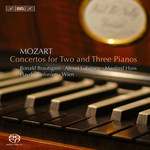
Concertos for Two and Three Pianos
 $35.00
Out of Stock
$35.00
Out of Stock2-6 weeks add to cart
W.A. MOZART
Concertos for Two and Three Pianos
Ronald Brautigam and Alexei Lubimov (fortepianos) / Haydn Sinfonietta Wien / Manfred Huss (direction and fortepiano)
[ BIS / SACD ]
Release Date: Saturday 1 September 2007
This item is currently out of stock. We expect to be able to supply it to you within 2 - 6 weeks from when you place your order.
"In short, this CD is a delight from begin to end. It will make you want to see and hear the two pieces performed live because only then can one fully enjoy the virtuosic playfulness and beauty of the musical interchange between the two pianos in the Concerto in E flat major; not to mention the pure divertimento of the Concerto in F major, which is a recreational, uplifting and entertaining"
(MusicWeb Recording of the Month Jan 2008).
Please note: The music on this Hybrid Super Audio CD can be played back in Stereo (CD and SACD) as well as in 5.0 Surround sound (SACD).
MusicWeb - Recording of the Year 2008
"Ronald Brautigam and Alexei Lubimov conjure sparkling interplay between their fortepianos and there is certainly no ploy to pass off their instruments as soft and discreet ancestors of the modern Steinway; one senses each soloist relishing the distinctive timbre of their modern copies of an instrument by the Viennese piano-maker Anton Walther (presumably much like the one that Mozart himself owned and used for his public piano concerto performances). There is a kind of elastic flexibility in the articulation of their solo passages quite different from the smooth lyricism one would expect in more polite and glossy conventional performances. The Haydn Sinfonietta of Vienna produce forthright performances."
(Gramophone Magazine May 2008)
"In short, this CD is a delight from begin to end. It will make you want to see and hear the two pieces performed live because only then can one fully enjoy the virtuosic playfulness and beauty of the musical interchange between the two pianos in the Concerto in E flat major; not to mention the pure divertimento of the Concerto in F major, which is a recreational, uplifting and entertaining"
(MusicWeb Recording of the Month Jan 2008)
There is only a limited number of works for two or more solo instruments with orchestra. One reason may be that the concerto genre in the 19th century became the stomping ground of the great virtuosi of the day, and the works themselves vehicles for the great and unique talent of one, special performer - not two, or three. Mozart, however, was evidently attracted by the sinfonia concertante genre and created some of the finest examples of it, such as the Sinfonia Concertante for Violin and Viola and the Concerto for Flute and Harp, as well as his two concertos for more than one piano. The 'Lodron Concerto' for three pianos was composed in 1776 for Countess Lodron and her daughters. It is Mozart's third piano concerto and the young man's irrepressible sense of fun is obvious: in his liner notes conductor and pianist Manfred Huss calls the concerto 'a true musical joke, in which the musical line is divided between the three players quite arbitrarily; one piano continues what another has started and the third will conclude. The listener hardly notices the humour, however, as the music sounds quite "normal", and only the pianists know (and the score shows) what Mozart is up to.' When the composer three years later returns to the task of writing for more than one piano, the result is quite different. The Concerto in E flat major KV 365, composed for Mozart himself and his sister Nannerl, is according to Huss 'in many respects Mozart's first 'big' piano concerto. It is the first in which we find the very characteristic intertwining of the woodwind and the piano part, accomplished very effectively and virtuosically.' Mozart seems to have been fond of the work, so fond that for a later performance he added clarinets, trumpets and timpani to the orchestra. Both versions of the score are found on the present recording, played by Alexei Lubimov and Ronald Brautigam, two of today's finest performers on the fortepiano. The two versions frame the triple concerto, in which Lubimov and Brautigam are joined by Manfred Huss, artistic director of the eminent Haydn Sinfonietta Wien, who here make their first appearance on BIS.
Tracks:
Concerto in E flat major for two pianos, KV365
Concerto in F major for three pianos, KV242 ('Lodron Concerto')
Concerto in E flat major for two pianos, KV365 - version with clarinets, trumpets & timpani



